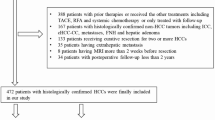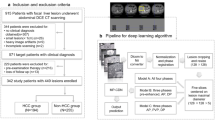Abstract
Hepatic hemangioma (HH) and hepatoblastoma (HBL) are common pediatric liver tumors and present with similar clinical manifestations with limited distinguishing value of serum AFP in early infancy. An accurate differentiation diagnostic tool is warranted for optimizing treatments and improving prognosis. The present study aimed to develop an innovative and cost-effective diagnostic tool to differentiate HH and HBL in early infancy using advanced deep learning (DL) techniques. One hundred forty patients ≤4 months old diagnosed as HH or HBL with histological specimens were recruited from two institutions assigned into a training set with cross-validation and a testing set for external validation, respectively. Based on MRI images, imaging diagnoses were interpreted by two radiologists, and imaging-derived radiomic features were extracted by pretrained convolutional neural networks (CNNs)-Xception extractor via DL analysis. A nomogram model was constructed integrating predictive clinical variables, radiologist-based interpretation, and DL features, evaluated comprehensively on diagnostic and calibration accuracy. The DL-based model performed an area under the receiver operating characteristic curve (AUC) of 0.966 for the training cohort and 0.864 for the testing cohort. The radiologist-interpreted differentiation model showed an AUC of 0.837 in the testing cohort. The integrated nomogram model represented an increasing performance with an AUC of 0.887, accuracy of 78.57%, sensitivity of 76.19%, and specificity of 80.95% in the testing cohort.
Conclusion: The MRI-based integrated model, a noninvasive preoperative diagnostic tool, yielded favorable efficacy for differentiating HH and HBL in early infancy, which might reduce the patients’ costs of repetitive and unnecessary examinations or over-treatment.
Trial registration: ClinicalTrials.gov Identifier: NCT05170282.
What is Known: • Hepatic hemangioma (HH) and hepatoblastoma (HBL) are common pediatric liver tumors and present with similar clinical manifestations with limited distinguishing value of serum AFP in early infancy. • Considering the rare incidence of infantile hepatic tumors, the distinguishing accuracy between HBL and HH for cases in early infancy is unsatisfactory for radiologists’ recognition solely. | |
What is New: • The MRI-based integrated model, a noninvasive preoperative diagnostic tool yielded favorable efficacy for differentiating HH and HBL in early infancy, which might reduce the patients’ costs of repetitive and unnecessary examinations or over-treatment. |

Similar content being viewed by others
Data availability
The data used and/or analysed during the current study is available from the corresponding author on reasonable request.
Abbreviations
- DL:
-
Deep learning
- HH:
-
Hepatic hemangioma
- HBL:
-
Hepatoblastoma
- CNN:
-
Convolutional neural network
- AUC:
-
Area under the receiver operating characteristic curve
- MRI:
-
Magnetic resonance imaging
- AFP:
-
Serum alpha fetoprotein
- ALBI:
-
Albumin-bilirubin
- ROI:
-
Region of interest
- SVM:
-
Support vector machine
References
Jha P, Chawla SC, Tavri S et al (2009) Pediatric liver tumors–a pictorial review. Eur Radiol 19:209–219
Iacobas I, Phung TL, Adams DM et al (2018) Guidance document for hepatic hemangioma (infantile and congenital) evaluation and monitoring. J Pediatr 203:294-300
Herzog CE, Andrassy RJ, Eftekhari F (2000) Childhood cancers: hepatoblastoma. Oncologist 5:445–453
Ferraro S, Panzeri A, Braga F et al (2019) Serum α-fetoprotein in pediatric oncology: not a children’s tale. Clin Chem Lab Med 57:783–797
Navarro OM (2016) Magnetic resonance imaging of pediatric soft-tissue vascular anomalies. Pediatr Radiol 46:891–901
Gnarra M, Behr G, Kitajewski A et al (2016) History of the infantile hepatic hemangioma: from imaging to generating a differential diagnosis. World J Clin Pediatr 5:273–280
LeCun Y, Bengio Y, Hinton G (2015) Deep learning. Nature 521:436–444
Yamashita R, Nishio M, Do RKG et al (2018) Convolutional neural networks: an overview and application in radiology. Insights Imaging 9:611–629
Kermany DS, Goldbaum M, Cai W et al (2018) Identifying medical diagnoses and treatable diseases by image-based deep learning. Cell 172:1122-1131
Johnson PJ, Berhane S, Kagebayashi C et al (2015) Assessment of liver function in patients with hepatocellular carcinoma: a new evidence-based approach-the ALBI grade. J Clin Oncol 33:550–558
Author information
Authors and Affiliations
Contributions
Yuhan Yang: investigation, data curation, methodology, visualization, writing-original draft preparation. Zongguang Zhou: validation, writing-review and editing. Yuan Li: conceptualization, supervision, writing-review and editing.
Corresponding author
Ethics declarations
Ethics approval
This study obtained the ethics approval from West China Hospital, Sichuan University.
Consent to participate
The consent to participate was waived considering the ethics standards of study design of retrospective cohort in this study.
Conflict of interest
The authors declare no competing interests.
Additional information
Communicated by Peter de Winter
Publisher's Note
Springer Nature remains neutral with regard to jurisdictional claims in published maps and institutional affiliations.
Supplementary Information
Below is the link to the electronic supplementary material.
Rights and permissions
Springer Nature or its licensor (e.g. a society or other partner) holds exclusive rights to this article under a publishing agreement with the author(s) or other rightsholder(s); author self-archiving of the accepted manuscript version of this article is solely governed by the terms of such publishing agreement and applicable law.
About this article
Cite this article
Yang, Y., Zhou, Z. & Li, Y. MRI-based deep learning model for differentiation of hepatic hemangioma and hepatoblastoma in early infancy. Eur J Pediatr 182, 4365–4368 (2023). https://doi.org/10.1007/s00431-023-05113-x
Received:
Revised:
Accepted:
Published:
Issue Date:
DOI: https://doi.org/10.1007/s00431-023-05113-x




